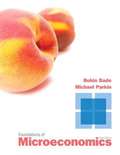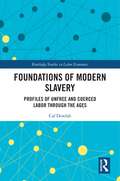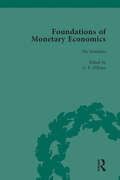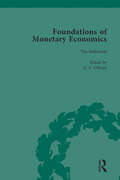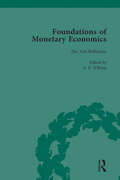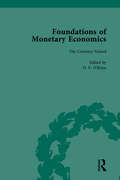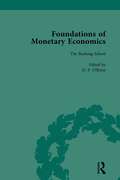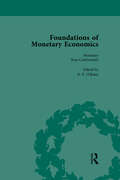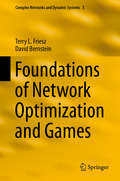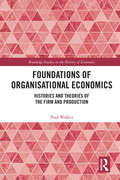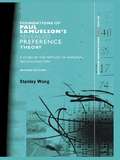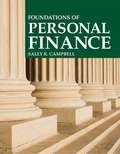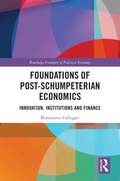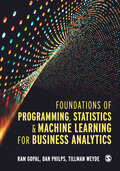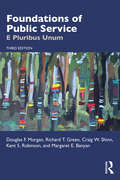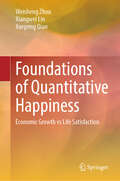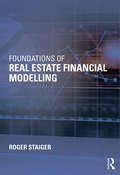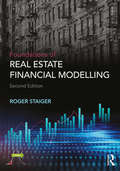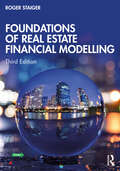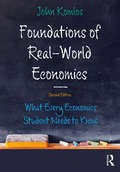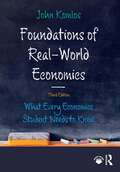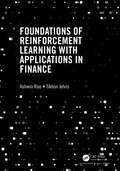- Table View
- List View
Foundations of Microeconomics (6th Edition)
by Robin Bade Michael ParkinTo help students in understanding the foundations of economic principles that can help them navigate the economic forces and guide their decisions.
Foundations of Modern Slavery: Profiles of Unfree and Coerced Labor through the Ages (Routledge Studies in Labour Economics)
by Caf DowlahThis is an academic inquiry into how labor power has been dehumanized and commodified around the world through the ages for capital accumulation and industrialization, and colonial and post-colonial economic transformation. The study explores all major episodes of slaveries beginning from the ancient civilizations to the end of Transatlantic Slave Trade in the eighteenth century; the worlds of serfdoms in the context of Western Europe, Eastern Europe, and Russia; the worlds of feudalisms in the context of Latin America, Japan, China, and India; the worlds of indentured servitudes in the context of the Europeans, the Indians, and the Chinese; the worlds of guestworkers in the contexts of the United States and Western Europe; the worlds of migrant labor programs in the context of the Gulf States; and the contemporary world of neoslavery focusing on human trafficking in both developing and developed countries, and forced labor in global value chains. The book is designed not only for students and academia in labor economics, labor history, and global socio-economic and political transformations, but also for the intelligent and inquiring policy makers, reformers, and general readers across the disciplinary pursuits of Economics, Political Science, History, Sociology, Anthropology, and Law.
Foundations of Monetary Economics, Vol. 1: The Founders
by D P O'BrienA multi-volume work which examines key texts from literature, providing a useful resource for the study of the foundations of monetary economics from writers such as Ricardo, Cantillon and Hume.
Foundations of Monetary Economics, Vol. 2: The Bullionists
by D P O'BrienA multi-volume work which examines key texts from literature, providing a useful resource for the study of the foundations of monetary economics from writers such as Ricardo, Cantillon and Hume.
Foundations of Monetary Economics, Vol. 3: The Anti-Bullionists
by D P O'BrienA multi-volume work which examines key texts from literature, providing a useful resource for the study of the foundations of monetary economics from writers such as Ricardo, Cantillon and Hume.
Foundations of Monetary Economics, Vol. 4: The Currency School
by D P O'BrienA multi-volume work which examines key texts from literature, providing a useful resource for the study of the foundations of monetary economics from writers such as Ricardo, Cantillon and Hume.
Foundations of Monetary Economics, Vol. 5: The Banking School
by D P O'BrienA multi-volume work which examines key texts from literature, providing a useful resource for the study of the foundations of monetary economics from writers such as Ricardo, Cantillon and Hume.
Foundations of Monetary Economics, Vol. 6: Monetary Non-Conformists
by D P O'BrienA multi-volume work which examines key texts from literature, providing a useful resource for the study of the foundations of monetary economics from writers such as Ricardo, Cantillon and Hume.
Foundations of Network Optimization and Games
by David Bernstein Terry L. FrieszThis is a book about infrastructure networks that are intrinsically nonlinear. The networks considered range from vehicular networks to electric power networks to data networks. The main point of view taken is that of mathematical programming in concert with finite-dimensional variational inequality theory. The principle modeling perspectives are network optimization, the theory of Nash games, and mathematical programming with equilibrium constraints. Computational methods and novel mathematical formulations are emphasized. Among the numerical methods explored are network simplex, gradient projection, fixed-point, gap function, Lagrangian relaxation, Dantzig-Wolfe decomposition, simplicial decomposition, and computational intelligence algorithms. Many solved example problems are included that range from simple to quite challenging. Theoretical analyses of several models and algorithms, to uncover existence, uniqueness and convergence properties, are undertaken. The book is meant for use in advanced undergraduate as well as doctoral courses taught in civil engineering, industrial engineering, systems engineering, and operations research degree programs. At the same time, the book should be a useful resource for industrial and university researchers engaged in the mathematical modeling and numerical analyses of infrastructure networks.
Foundations of Organisational Economics: Histories and Theories of the Firm and Production (Routledge Studies in the History of Economics)
by Paul WalkerFoundations of Organisational Economics: Histories and Theories of the Firm and Production delves into a range of key topics to do with the history of the mainstream approach to the theory of production and the theory of the firm. This includes the frameworks used to analyse production, the division of labour and its application to the firm and the development of the neoclassical model of production. The first topic explored is the change from a normative approach to a largely positive approach to the analysis of the theory of production, which occurred around the seventeenth century. The next topic is an examination of the relationship (or the lack of a relationship) between the division of labour and the theory of the firm. In the fourth chapter, the focus is on the development of the proto-neoclassical approach to production. Here, the development of the theories of monopoly, oligopoly and perfect competition are discussed, as well as the theory of input utilisation. Chapter 5 looks at Marshall’s idea of the representative firm, which was the main early neoclassical approach to the theory of industry-level production. The penultimate chapter considers the criticisms made of the neoclassical model between 1940 and 1970. This work is an illuminating reference for students and researchers of the history of economic thought, industrial organisation, microeconomic theory and organisational studies.
Foundations of Paul Samuelson's Revealed Preference Theory: A study by the method of rational reconstruction (Routledge INEM Advances in Economic Methodology)
by Stanley WongOriginally published over two decades ago, this classic text within the philosophy of economics is a tour de force against revealed preference. It critically examines the research programme carried out by the Nobel Prize winner Paul Samuelson on the revealed preference approach to the theory of consumer behaviour. It also challenges two essential premises: * that the programme has been completed * that the various contributions of Samuelson are mutually consistent. This text contains a new preface by Wong, in which he provides a detailed insight into the origins of his pioneering text, and a new introduction from Philip Mirowski, analyzing the impact The Foundation of Paul Samuelson’s Revealed Preference Theory has had on the discipline of economics as well as explaining why it remains core reading for economists today. The defining statement of economic method, this book will be of interest to economists everywhere.
Foundations of Personal Finance (Eighth Edition)
by Sally R. CampbellWhether you teach classes in Family and Consumer Sciences or Business, Foundations of Personal Finance is the right text for you. It introduces students to fundamental economic concepts so they can better understand an increasingly complex world. They learn how to identify and manage resources to achieve their own economic goals. A chapter covers each personal finance area: taxes, credit, insurance, savings, investments, and financial institutions. Students also learn how to make wise decisions about the things that affect many household budgets: food, clothing, transportation, housing, technology, and health. The text challenges students to plan their futureswith education, job training, and careersand help make environmental resources available for future generations. Each chapter contains colorful photos and charts, compelling case studies, career profiles, reports about current global issues, and related content from other academic areas.
Foundations of Physical Education, Exercise Science, and Sport (Eighteenth Edition)
by Deborah A. Wuest Jennifer L. FisetteThis is an exciting time to prepare for a career in physical education, exercise science, or sport. Scientific evidence supports the significant contribution of physical activity to health, interest and participation in sport continues to grow, and physical education has the potential to help young people learn to be active for a lifetime.
Foundations of Post-Schumpeterian Economics: Innovation, Institutions and Finance (Routledge Frontiers of Political Economy)
by Beniamino CallegariThe neo-Schumpeterian interpretation dominating the field of evolutionary economics puts focus on technological innovation, Darwinian evolution and economic growth, and has proven to be fertile ground for the past forty years. However, as the evolutionary school attempts to engage with a world of inequality, financialization and economic fragility, the limits of such an interpretation begin to show. Contributing to the development of a more balanced post-Schumpeterian economics, this book offers a complementary interpretation of Schumpeter’s theory which is based on economic innovation, Bergsonian creative evolution and monetary mechanisms and institutions. The theoretical consequences of this new interpretation are significant and numerous. First, it leads to a conceptual separation of economic and technological innovation. Second, it offers a deeper integration of monetary and financial elements within the theory of the process of development, illustrating the adaptive and planning role provided by financial speculation under capitalist conditions. Third, it provides the foundations for a post-Schumpeterian theory of capitalist crisis, built on the relationship between innovation funding, the institutional development of banking and speculative credit creation. Finally, by discussing several key recent developments in evolutionary economics, the interpretation illustrates the opportunities unlocked by a pluralist approach to disciplinary development, aiming towards the development of a comprehensive post-Schumpeterian approach to economics. This text is essential reading for scholars and students of Schumpeter, evolutionary economics, post-Keynesian economics, institutional economics and all economists interested in the ontological, methodological and theoretical challenges posed by economic development.
Foundations of Predictive Analytics
by James Wu Stephen CoggeshallDrawing on the authors' two decades of experience in applied modeling and data mining, Foundations of Predictive Analytics presents the fundamental background required for analyzing data and building models for many practical applications, such as consumer behavior modeling, risk and marketing analytics, and other areas. It also discusses a variety
Foundations of Programming, Statistics, and Machine Learning for Business Analytics
by Ram Gopal Dan Philps Tillman WeydeBusiness Analysts and Data Scientists are in huge demand, as global companies seek to digitally transform themselves and leverage their data resources to realize competitive advantage. This book covers all the fundamentals, from statistics to programming to business applications, to equip you with the solid foundational knowledge needed to progress in business analytics. Assuming no prior knowledge of programming or statistics, this book takes a simple step-by-step approach which makes potentially intimidating topics easy to understand, by keeping Maths to a minimum and including examples of business analytics in practice. Key features: · Introduces programming fundamentals using R and Python · Covers data structures, data management and manipulation and data visualization · Includes interactive coding notebooks so that you can build up your programming skills progressively Suitable as an essential text for undergraduate and postgraduate students studying Business Analytics or as pre-reading for students studying Data Science. Ram Gopal is Pro-Dean and Professor of Information Systems at the University of Warwick. Daniel Philps is an Artificial Intelligence Researcher and Head of Rothko Investment Strategies. Tillman Weyde is Senior Lecturer at City, University of London.
Foundations of Psychological Profiling: Terrorism, Espionage, and Deception
by Richard BloomProfiling is a hot topic today. The post-9/11 "War on Terrorism" has engendered political, ethical, and scientific controversy over its use. The proliferation of recent films, television programs, and books is a sociocultural indicator of widespread interest. Designed for a diverse audience including law enforcement officers, intelligence and secur
Foundations of Public Service: E Pluribus Unum
by Kent S. Robinson Douglas F. Morgan Craig W. Shinn Richard T. Green Margaret E. BanyanDesigned to serve as a basic text for introductory courses in public administration, this pioneering work provides students with a clear-eyed understanding of the vital management functions covered in most standard textbooks with two important differences. First, it is written to address the needs of both the experienced practitioner and the entry-level public servant. Case examples bridge the content-rich environment of practitioners with the principles of public administration sought by pre-service students. Second, the discussion of management practices is grounded in the political and ethical tensions inherent in the American constitutional form of governance. This innovative approach reflects the authors' belief that public administration operates as an integral part of the country's political traditions, and thereby helps define the political culture. Key themes in this third edition include: • an emphasis on the ways in which public administration and their agents play a critical role in ensuring legal and political accountability of the political system; • an exploration of local public administration as the backstop of American democracy, requiring a close working partnership between part-time elected officials and career administrators; • careful examination of the ways in which the American political economy requires administrators who are skilled at co-producing the common good with voluntary associations, businesses, nonprofit organizations and other governmental entities; • an understanding that public administration plays a critical role with its prudential judgments in balancing the competing values necessary to secure a regime of ordered liberty. Every chapter has been thoroughly updated, with particular attention paid to chapters on budgeting and revenue, e-government and the digital divide, shared power and the rise of "wicked problems," and the future of public administration in the United States amidst deep polarization. Foundations of Public Service, 3rd Edition provides a framework for understanding American political traditions and how they inform public administration as a political practice. It is required reading for all introductory Public Administration courses with an emphasis on practice and real-world applications.
Foundations of Quantitative Happiness: Economic Growth vs Life Satisfaction
by Weisheng Zhou Xuepeng Qian Xiangwei LinThis book is a rarity in that it conducts a comparative study of life satisfaction between Japan and China over a wider area and time period, filling a gap in empirical research on life satisfaction. Unlike many other countries that have focused primarily on the pursuit of economic prosperity, this study objectively examines the relationship between economic growth and life satisfaction. This study examines various aspects of the proportion of individuals who report being satisfied with their lives, including time series and single-year comparisons, as well as the level and rate of economic growth. This study conducted independent questionnaire surveys in China and Japan, analyzed the impact of absolute income and relative income on life satisfaction, and then objectively examined and compared life satisfaction in China and Japan. Furthermore, this study proposes that real disposable income exceeding $8,000 is an important signal of a shift in the pursuit of "spiritual wealth" from an emphasis on "material wealth" among the Chinese and Japanese. In particular, questionnaire surveys, one for all of Japan and one specifically for Kyoto City, were conducted on the impact of the global pandemic COVID-19 on life satisfaction, and it was found that the original "US$8,000" line has risen to "US$15,000". This study not only enriches the understanding of the relationship between economic growth, COVID-19 and life satisfaction, but also provides a new perspective for policy making.
Foundations of Real Estate Financial Modelling
by Roger StaigerFoundations of Real Estate Financial Modelling is specifically designed to provide an overview of pro forma modelling for real estate projects. The book introduces students and professionals to the basics of real estate finance theory before providing a step-by-step guide for financial model construction using Excel. The idea that real estate is an asset with unique characteristics which can be transformed, both physically and financially, forms the basis of discussion. Individual chapters are separated by functional unit and build upon themselves to include information on: Amortization Single-Family Unit Multi-Family Unit Development/Construction Addition(s) Waterfall (Equity Bifurcation) Accounting Statements Additional Asset Classes Further chapters are dedicated to risk quantification and include scenario, stochastic and Monte Carlo simulations, waterfalls and securitized products. This book is the ideal companion to core real estate finance textbooks and will boost students Excel modelling skills before they enter the workplace. The book provides individuals with a step-by-step instruction on how to construct a real estate financial model that is both scalable and modular. A companion website provides the pro forma models to give readers a basic financial model for each asset class as well as methods to quantify performance and understand how and why each model is constructed and the best practices for repositioning these assets.
Foundations of Real Estate Financial Modelling
by Roger StaigerFoundations of Real Estate Financial Modelling, Second Edition is specifically designed to provide the scalable basis of pro forma modelling for real estate projects. The book introduces students and professionals to the basics of real estate finance theory prior to providing a step-by-step guide for financial real estate model construction using Excel. The book introduces an innovative new financial metric, P(Gain), which quantifies the probability of a Return of Capital and answers the most basic question for investing, "What is the probability I get my money back?".? This new second edition has been fully revised and expanded. The book is separated into three functional units: (1) Real Estate Valuation Basics, Theory and Skills, (2) Real Estate Pro Forma Modelling, (3) Real Estate Pro Forma (Enhancements). New and enhanced Chapters cover:? Interest rates Amortization Single- and multi-family unit Development module Rent roll module Waterfall (equity bifurcation) Hotel, retail/office and townhouse. ? In addition, this new edition includes problem sets and solutions at the end of each chapter as well as case studies underpinning the chapter topics. Further chapters are dedicated to risk quantification and include scenario, stochastic and Monte Carlo simulations, equity waterfalls, and adding U.S. GAAP financial statements to existing real estate pro forma models. This book is the ideal textbook for a Real Estate Finance class, providing the theoretical basis of real estate finance as well as valuable modelling skills for the workplace. This book provides individuals with a step-by-step instruction on how to construct a real estate financial model starting with a new spreadsheet. The resultant model is portable, scalable, and modular. A companion website provides the pro forma models to readers as a reference for their own constructed models.
Foundations of Real Estate Financial Modelling
by Roger StaigerNAMED ONE OF THE BEST COMMERCIAL REAL ESTATE BOOKS BY THE MOTLEY FOOL "Staiger gives us the technical tools needed to build robust pro forma modeling around our real estate assets." –MillionAcres Now in its third edition, Foundations of Real Estate Financial Modelling equips a new generation of students and professionals with a resource MillionAcres guarantees they’ll "use throughout [their] commercial investing career[s]." Designed to provide increased scalable basis of pro forma modelling for real estate projects, this complete update and revision of the classic text offers a step-by-step introduction to building and understanding the models underlying investments in properties from single-family rentals to large-scale developments. Case studies drawn from the author’s storied investment career put models into real-world context while problem sets at the end of each chapter provide hands-on practice for learners at any stage of their real estate careers. This edition employs the innovative financial metric P(Gain) to quantify the probability of a Return of Capital, ensuring readers’ ability to answer the most fundamental question of investing—What is the probability I’ll get my money back? The fully revised and enhanced third edition is organized in three functional units: (1) Real Estate Valuation Basics, Theory, and Skills, (2) Real Estate Pro Forma Modelling, and (3) Real Estate Pro Forma (Enhancements). Chapters cover: Interest Rates (Prime, LIBOR, SOFR) Amortization (Cash-Out Refinance modelling) ADC (Acquisition, Development, Construction) Module Rent Roll Module (including seasonality) Waterfall Hotel Consolidation Stochastic Modelling and Optimization Additional chapters are dedicated to risk quantification and include scenario, stochastic, and Monte Carlo simulations, equity waterfalls, and integration of US GAAP financial statements. A companion website provides the real estate pro forma models to readers as a reference for their own constructed models, www.pgainllc.com. An ideal companion in the classroom and the boardroom, this new edition of Foundations of Real Estate Financial Modelling will make even novices the "experts in the room on [their] chosen asset class" (MillionAcres).
Foundations of Real World Economics: What Every Economics Student Needs to Know
by John KomlosThe 2008 financial crisis, the rise of Trumpism and the other populist movements which have followed in their wake have grown out of the frustrations of those hurt by the economic policies advocated by conventional economists for generations. Despite this, textbooks continue to praise conventional policies such as deregulation and hyperglobalization. This textbook demonstrates how misleading it can be to apply oversimplified models of perfect competition to the real-world. The math works well on college blackboards but not so well on the Main Streets of America. This volume explores the realities of oligopolies, the real impact of the minimum wage, the double-edged sword of free trade, and other ways in which powerful institutions cause distortions in the mainstream models. Bringing together the work of key scholars, such as Kahneman, Minsky, and Schumpeter, this book demonstrates how we should take into account the inefficiencies that arise due to asymmetric information, mental biases, unequal distribution of wealth and power, and the manipulation of demand. This textbook offers students a valuable introductory text with insights into the workings of real markets not just imaginary ones formulated by blackboard economists. A must-have for students studying the principles of economics as well as micro- and macroeconomics, this textbook redresses the existing imbalance in economic teaching. Instead of clinging to an ideology that only enriched the 1%, Komlos sketches the outline of a Capitalism with a human face, an economy in which people live contented lives with dignity instead of focusing on GNP.
Foundations of Real-World Economics: What Every Economics Student Needs to Know
by John KomlosThe 2008 financial crisis, the rise of Trumpism, and the other populist movements which have followed in their wake have grown out of the frustrations of those hurt by the economic policies advocated by conventional economists for generations. Despite this, textbooks remain frozen in time, continuing to uphold traditional policies as though nothing has happened. Foundations of Real-World Economics demonstrates how misleading it can be to apply oversimplified models of perfect competition to the real world. The math works well on college blackboards but not so well on the Main Streets of America. This volume explores the realities of oligopolies, the real impact of the minimum wage, the double-edged sword of free trade, and other ways in which powerful institutions cause distortions in mainstream models. Bringing together the work of key scholars like Kahneman, Minsky, and Schumpeter, this textbook takes into consideration the inefficiencies that arise when the perfectly competitive model is applied to the real world dominated by multinational oligopolies. The third edition has been updated throughout, bringing in new material on the financial crises, the rise of populism, racism, inequality, climate change, and the Covid-19 pandemic. A must-have for students studying the principles of economics as well as micro- and macroeconomics, this textbook redresses the existing imbalance in economic teaching as John Komlos focuses on the paradigm of humanistic economics.
Foundations of Reinforcement Learning with Applications in Finance
by Ashwin Rao Tikhon JelvisFoundations of Reinforcement Learning with Applications in Finance aims to demystify Reinforcement Learning, and to make it a practically useful tool for those studying and working in applied areas — especially finance. Reinforcement Learning is emerging as a powerful technique for solving a variety of complex problems across industries that involve Sequential Optimal Decisioning under Uncertainty. Its penetration in high-profile problems like self-driving cars, robotics, and strategy games points to a future where Reinforcement Learning algorithms will have decisioning abilities far superior to humans. But when it comes getting educated in this area, there seems to be a reluctance to jump right in, because Reinforcement Learning appears to have acquired a reputation for being mysterious and technically challenging. This book strives to impart a lucid and insightful understanding of the topic by emphasizing the foundational mathematics and implementing models and algorithms in well-designed Python code, along with robust coverage of several financial trading problems that can be solved with Reinforcement Learning. This book has been created after years of iterative experimentation on the pedagogy of these topics while being taught to university students as well as industry practitioners. Features Focus on the foundational theory underpinning Reinforcement Learning and software design of the corresponding models and algorithms Suitable as a primary text for courses in Reinforcement Learning, but also as supplementary reading for applied/financial mathematics, programming, and other related courses Suitable for a professional audience of quantitative analysts or data scientists Blends theory/mathematics, programming/algorithms and real-world financial nuances while always striving to maintain simplicity and to build intuitive understanding.
